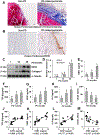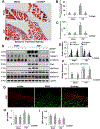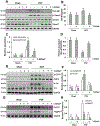Genetic or pharmacologic blockade of enhancer of zeste homolog 2 inhibits the progression of peritoneal fibrosis
- PMID: 31579944
- PMCID: PMC7481741
- DOI: 10.1002/path.5352
Genetic or pharmacologic blockade of enhancer of zeste homolog 2 inhibits the progression of peritoneal fibrosis
Abstract
Dysregulation of histone methyltransferase enhancer of zeste homolog 2 (EZH2) has been implicated in the pathogenesis of many cancers. However, the role of EZH2 in peritoneal fibrosis remains unknown. We investigated EZH2 expression in peritoneal dialysis (PD) patients and assessed its role in peritoneal fibrosis in cultured human peritoneal mesothelial cells (HPMCs) and murine models of peritoneal fibrosis induced by chlorhexidine gluconate (CG) or high glucose peritoneal dialysis fluid (PDF) by using 3-deazaneplanocin A (3-DZNeP), and EZH2 conditional knockout mice. An abundance of EZH2 was detected in the peritoneum of patients with PD associated peritonitis and the dialysis effluent of long-term PD patients, which was positively correlated with expression of TGF-β1, vascular endothelial growth factor, and IL-6. EZH2 was found highly expressed in the peritoneum of mice following injury by CG or PDF. In both mouse models, treatment with 3-DZNeP attenuated peritoneal fibrosis and inhibited activation of several profibrotic signaling pathways, including TGF-β1/Smad3, Notch1, epidermal growth factor receptor and Src. EZH2 inhibition also inhibited STAT3 and nuclear factor-κB phosphorylation, and reduced lymphocyte and macrophage infiltration and angiogenesis in the injured peritoneum. 3-DZNeP effectively improved high glucose PDF-associated peritoneal dysfunction by decreasing the dialysate-to-plasma ratio of blood urea nitrogen and increasing the ratio of dialysate glucose at 2 h after PDF injection to initial dialysate glucose. Moreover, delayed administration of 3-DZNeP inhibited peritoneal fibrosis progression, reversed established peritoneal fibrosis and reduced expression of tissue inhibitor of metalloproteinase 2, and matrix metalloproteinase-2 and -9. Finally, EZH2-KO mice exhibited less peritoneal fibrosis than EZH2-WT mice. In HPMCs, treatment with EZH2 siRNA or 3-DZNeP suppressed TGF-β1-induced upregulation of α-SMA and Collagen I and preserved E-cadherin. These results indicate that EZH2 is a key epigenetic regulator that promotes peritoneal fibrosis. Targeting EZH2 may have the potential to prevent and treat peritoneal fibrosis. © 2019 Pathological Society of Great Britain and Ireland. Published by John Wiley & Sons, Ltd.
Keywords: angiogenesis; enhancer of zeste homolog 2; epithelial-to-mesenchymal transition; peritoneal fibrosis; profibrotic signaling pathways.
© 2019 Pathological Society of Great Britain and Ireland. Published by John Wiley & Sons, Ltd.
Figures






Similar articles
-
Inhibition of EZH2 suppresses peritoneal angiogenesis by targeting a VEGFR2/ERK1/2/HIF-1α-dependent signaling pathway.J Pathol. 2022 Oct;258(2):164-178. doi: 10.1002/path.5987. Epub 2022 Aug 16. J Pathol. 2022. PMID: 35792675
-
Non-steroidal mineralocorticoid receptor antagonist finerenone inhibits peritoneal fibrosis induced by high-glucose dialysate via regulating enhancer of zeste homolog 2 (EZH2) expression.Ren Fail. 2025 Dec;47(1):2491156. doi: 10.1080/0886022X.2025.2491156. Epub 2025 May 13. Ren Fail. 2025. PMID: 40364455 Free PMC article.
-
Blockade of enhancer of zeste homolog 2 alleviates renal injury associated with hyperuricemia.Am J Physiol Renal Physiol. 2019 Mar 1;316(3):F488-F505. doi: 10.1152/ajprenal.00234.2018. Epub 2018 Dec 19. Am J Physiol Renal Physiol. 2019. PMID: 30566000 Free PMC article.
-
Pathophysiological Mechanisms of Peritoneal Fibrosis and Peritoneal Membrane Dysfunction in Peritoneal Dialysis.Int J Mol Sci. 2024 Aug 7;25(16):8607. doi: 10.3390/ijms25168607. Int J Mol Sci. 2024. PMID: 39201294 Free PMC article. Review.
-
Reprogramming of Mesothelial-Mesenchymal Transition in Chronic Peritoneal Diseases by Estrogen Receptor Modulation and TGF-β1 Inhibition.Int J Mol Sci. 2020 Jun 10;21(11):4158. doi: 10.3390/ijms21114158. Int J Mol Sci. 2020. PMID: 32532126 Free PMC article. Review.
Cited by
-
Elevated expression of HDAC6 in clinical peritoneal dialysis patients and its pathogenic role on peritoneal angiogenesis.Ren Fail. 2020 Nov;42(1):890-901. doi: 10.1080/0886022X.2020.1811119. Ren Fail. 2020. PMID: 32862739 Free PMC article.
-
Restoration of CPT1A-mediated fatty acid oxidation in mesothelial cells protects against peritoneal fibrosis.Theranostics. 2023 Aug 15;13(13):4482-4496. doi: 10.7150/thno.84921. eCollection 2023. Theranostics. 2023. PMID: 37649600 Free PMC article.
-
miR‑101a‑3p overexpression prevents acetylcholine‑CaCl2‑induced atrial fibrillation in rats via reduction of atrial tissue fibrosis, involving inhibition of EZH2.Mol Med Rep. 2021 Oct;24(4):740. doi: 10.3892/mmr.2021.12380. Epub 2021 Aug 26. Mol Med Rep. 2021. PMID: 34435649 Free PMC article.
-
LCZ696, an angiotensin receptor-neprilysin inhibitor, ameliorates epithelial-mesenchymal transition of peritoneal mesothelial cells and M2 macrophage polarization.Ren Fail. 2024 Dec;46(2):2392849. doi: 10.1080/0886022X.2024.2392849. Epub 2024 Aug 21. Ren Fail. 2024. PMID: 39165231 Free PMC article.
-
TGF-β1 Receptor Inhibitor SB525334 Attenuates the Epithelial to Mesenchymal Transition of Peritoneal Mesothelial Cells via the TGF-β1 Signaling Pathway.Biomedicines. 2021 Jul 19;9(7):839. doi: 10.3390/biomedicines9070839. Biomedicines. 2021. PMID: 34356903 Free PMC article.
References
-
- Zhou Q, Bajo MA, Del Peso G, et al. Preventing peritoneal membrane fibrosis in peritoneal dialysis patients. Kidney Int 2016; 90: 515–524. - PubMed
-
- Yao Q, Pawlaczyk K, Ayala ER, et al. The role of the TGF/Smad signaling pathway in peritoneal fibrosis induced by peritoneal dialysis solutions. Nephron Exp Nephrol 2008; 109: e71–78. - PubMed
Publication types
MeSH terms
Substances
Grants and funding
LinkOut - more resources
Full Text Sources
Molecular Biology Databases
Research Materials
Miscellaneous

